Growing Mango trees is a cool thing. When the trees grow, they will expand their branches and give a great place to relax by giving good shade. It will also contain some delicious fruits that you can eat. They may be delicious, but trees are susceptible to several diseases of Mango trees. Treating sick Mangoes means identifying the symptoms of Mango disease correctly.

There are some problems you will face while it continues to grow. You need to move to control and protect your tree when that problem occurs. When the Mango tree remains healthy, it will grow bigger and taller and bear large fruits. If the tree maintains its good condition, you can expect a lot of crops every year. Let’s check out 14 common Mango tree/plant problems below.
Common Mango tree/plant problems
Mango flower drop
Mango trees shed flowers all the time. On average, only 4 to 6 flower sets will fall eventually. But you know it’s a problem when the tree doesn’t have flowers left or the tree doesn’t bloom flowers at all. This is due to the lack of nutrition in the soil. The tree sucks the nutrients from the ground through the roots, then transports them to the stem, branches, and flowers.
Solution – You can mix 20 ml Panchagavya in 1litre water. Spray this mix once every 6 to 8 days. Spray it only in the evening, so that it can soak all night.
Mango fruit drop
The reason for the fruit drops in Mango is also nutritional deficiency. The tree spends immense energy sucking nutrients from the soil and transporting them to flowers. It encourages leaves to promote their photosynthesis, which produces and distributes the energy needed for flowers at this time and there.
Solution – For this, you can spray the Panchagavya mix even if the Mango increases to the size of the pea. This helps in the proper development of Mango and protects it from diseases.
No Mango fruit on a tree
The Most common Mango tree problems are related to Mango trees that do not produce.
Diseases
Anthracnose
Symptoms of anthracnose appear as black irregular-shaped lesions that gradually grow larger and cause leaf spots, bloom blight, fruit stains, and rots resulting in Mango trees not becoming fruit.
Solution – To avoid the problem, it is better to plant an anthracnose-resistant type of Mango tree in the full sun, where rain will quickly evaporate.
Powdery mildew
Powdery mildew attacks young fruits, flowers, and leaves, leaving these areas covered with white fungi powder and often causing wounds along the bottom of the leaves. The severe infection will destroy panicles, later affecting potential fruit sets and production, so the Mango tree does not produce fruit. Both these diseases get worse with severe loss and the onset of rain.
Solution – The early spring applications of sulfur and copper eliminate this fungal pathogen when the panicle is half its full size, and then 10 to 21 days later will help. To avoid these diseases, apply fungicide coating on sensitive parts when buds appear and start blooming and ending at harvest time.
Pests
Mites and scale pests can attack Mango trees, but generally, Mango trees do not result in producing fruit unless severe.
In case you missed it: Growing Mango Tree in Containers from Seed
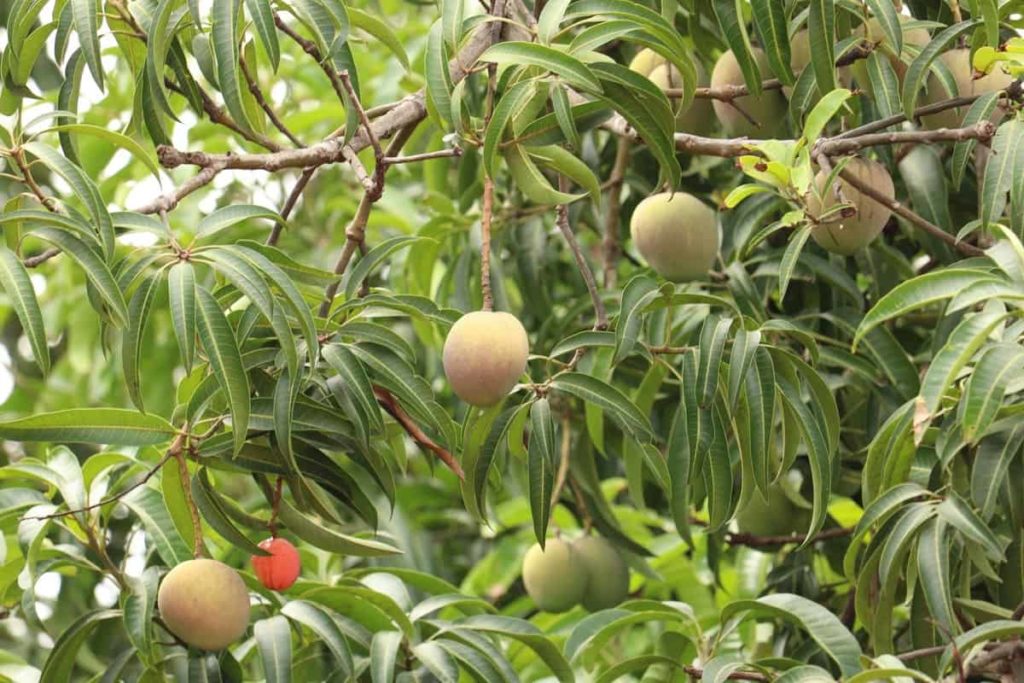
Solution – Treating a tree with neem oil can help reduce most pest problems.
Weather
Cold is the common factor in the Mango tree not producing fruits. Mango trees are extremely sensitive to cold temperatures and, therefore, should be planted in the safest area of the yard.
Solution – Ideally, plant your Mango tree on the south or east side of the house in full sun to prevent the issue of Mango fruit not having on the trees.
Fertilization
Heavy fertilization of lawns near Mango trees can reduce fruit as the Mango tree root system expands far beyond the tree drip line. Most of the time, their soil has an abundance of nitrogen.
Solution – You can remove this by adding phosphorus-rich fertilizer or bone meal to the soil around your Mango tree. Similarly, giving more water, like using lawn sprinklers, can reduce the quality of fruits or fruits.
Pruning
You can severely prune big trees to reduce the canopy height, making it possible for a simple crop and not injuring the tree; however, it can reduce fruit production from one to several periods.
Solution – Therefore, the pruning should only occur whenever necessary for shaping or maintenance. Otherwise, just prune to remove the broken or disease-surrounded plants.
Mango leaves turn yellow
Aging leaves
Yellowing of leaves is a standard process of tree growth. It is not a problem and is healthy for the tree. Those leaves will eventually turn brown and drop and replace new young leaves.
Solution – You don’t have to worry as long as the tree grows and produces lots of flowers and fruits. When the old leaves fall, new branches and leaves will grow on parts of the tree. It will make the tree healthy.
Too much water
When you give more water, the young Mango tree can experience the yellowing of leaves.
Solution – Regular water is needed to help set up small trees, but they should be careful watering. It’s great to give them water every two to three days. Giving them too much water, especially mature Mango trees, may experience their leaves to become yellow. You can give water once a week or every two weeks is okay. But if the rain is abundant, you don’t have to water them.
Water shortage
Dehydration can also be the reason for the yellowing of leaves.
Solution – No one else gives water to the tree, and the only water source is rain. If there are no people in the house who water the tree and there is no rain, the leaves may turn yellow. But the yellowing of Mango leaves is very low, especially for mature trees, due to lack of water. If they have no water, mature Mango trees can be fine even for some time.
In case you missed it: Mango Seed Germination, Process, Time, Temperature
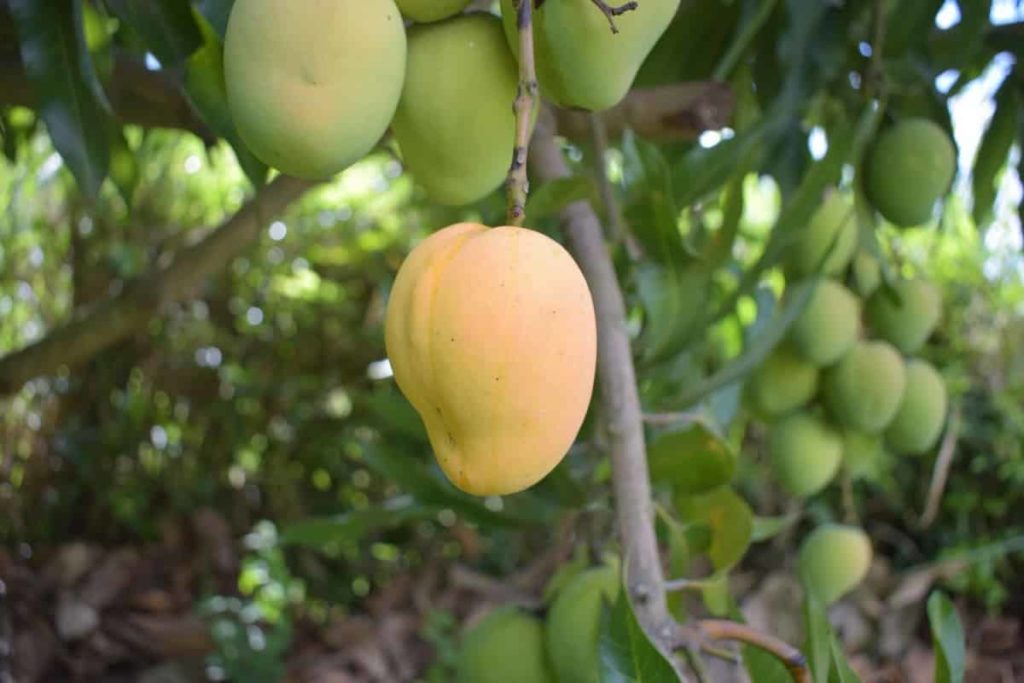
Nitrogen deficiency
Nitrogen is the important nutrient required for a Mango tree. When there is a lack of nitrogen, Mango leaves turn yellow.
Solution – When enough nitrogen is found on the ground, you will not see yellow leaves, or perhaps any factor will cause yellow leaves. Some tools can help determine soil quality, but if you don’t want to test it, you can only grow the tree, observe its growth, and add nitrogen if needed.
Verticillium wilt
Tree diseases such as Verticillium wilt can cause the yellowing of leaves.
Solution – It is best to prune out the affected parts. Fungicides are a great way to control this disease in Mango trees.
Low sunlight
Low sunlight can also be a factor as to why your Mango tree has yellow leaves. The tree needed at least 6 hours of direct sunlight. It’s great if it can receive 8 hours long.
Solution – If the tree gets less sunlight, it can be due to the large trees or houses around it. You need to grow your tree in an open area where the sun will not block.
Transplant shock
You can transplant young Mango trees inside the pots are being transplanted to the ground, which could lead to transplant shocks that could cause the yellowing of its leaves. Sometimes it happens because the plant and roots move to a new place. It’s a new surrounding for the plant.
Solution – You can prevent the transplant shock by carefully moving the tree to the ground. During the transplant, you must ensure you have already made a slightly larger hole on the tree’s root ball. It is to ensure that there is enough space to grow in the roots.
Mango tree dying
Lack of fertilizer
Lack of nutrients or fertilizer can cause the growth of Mango trees to slow down, the development of yellow or brown leaves, and eventually lead to plant death.
Solution – Keeping Mango trees well fertilized is the key to avoiding nutrient and mineral deficiency and avoiding your Mango tree dying slowly. Feed Mango trees with well-balanced fruit fertilizer in spring, or you can use pelleted chicken manure.
Dehydration
Dehydration, especially in the summer, can cause the Mango tree to die back quickly.
Solution – Deepwater Mango trees that have dried 2 inches below the soil level from your hose. You can apply water directly to the root zone and avoid spraying water on their leaves. You can add a bucket of water with diluted seaweed to help the plant restore and develop strong roots. Surround the plant with a thick surface of bark or straw mulch to help keep the water inside for longer.
Pest attack
Pests can attack Mango trees, especially in spring and summer when the weather is hot.
Solution – Sap-sucking pests such as aphids, thrips, and scale can all be controlled with neem oil spray. Set a sticking fruit fly trap around your yard to catch the fruit fly before they affect your fruit.
In case you missed it: Growing Mango Tree In Backyard – A Beginners Guide
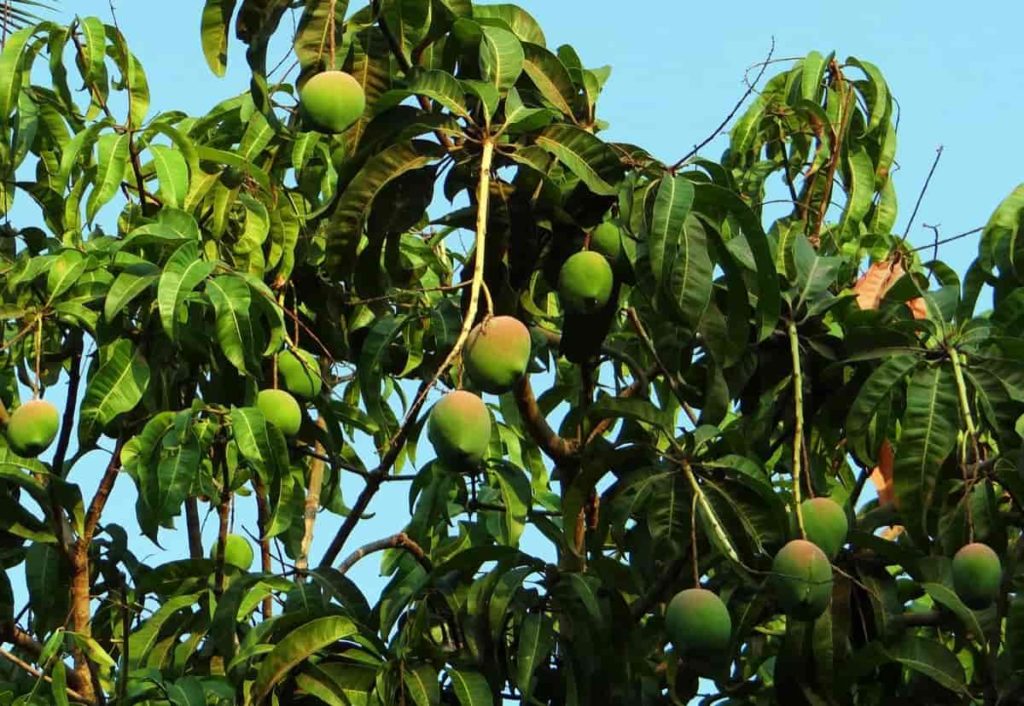
Anthracnose
Anthracnose can damage Mango trees and cause them to die.
Solution – This fungus can be prevented and treated with copper fungicide. Avoid watering the Mango tree on leaves and surround it with a mulch to prevent the soil from spraying on the leaves.
Overwater
Mango trees with more water can quickly lose nutrients, develop fungal disease, and die back over time.
Solution – Check the soil before watering your Mango tree in winter. The soil temperature will be low during the cold months, and they will remain wet for longer. Water the plant only once the soil dries up to avoid the growth of fungi on the roots.
The high amount of salt in water
Irrigating Mango trees with water burdened with salt and other minerals can cause damage and even death to the plant.
Solution – Flush Mango trees with fresh water; it can be fresh rainwater or tap water from any other source. It will wash the salts through the soil and help reduce their concentration around the roots of your Mango tree. Repeat the process after a week to help restore it. It’s best to switch to a water source low in salt, but regularly flushing the tree with fresh water will help combat the problem.
Mango leaves turning brown
Underwater
A Mango tree can last for a couple of days or weeks without water as it can maintain water inside its roots, branches, and bark. But too long can cause leaves to brown.
Solution – Brown leaves are rare for mature trees and common for small trees. If you want to water mature trees, it can happen once a week or every two weeks; that’s perfectly fine. But when drought and summer come, water is very important and essential.
Salt on soil
Another reason why Mango leaves are brown is salt on the soil. Too much salt content on the soil can cause Mango leaves to brown.
Solution – You cannot remove these salts one by one using your bare hands, but water can help a good way before planting a tree is to ensure that heavy water is given so that if there is a high level of salt in this place, it will be removed from the water.
Broken branches
Sometimes you see your tree with lots of brown leaves. Sometimes you didn’t know there was a broken branch. When a branch breaks down, all the leaves of this branch will be affected. It will turn yellow and brown as it is separated from the tree.
Solution – If you see that many leaves change color, you need to analyze your tree and see if there are broken branches. You need to protect your tree to prevent unwanted branch damage.
Pests
Pests are common for plants. This is also a possible reason why your Mango leaves are turning brown. Some Mango tree insects are mites, thrips, scales, and mealy bugs. They eat leaves and destroy branches and fruits.
Solution – Pest control will usually work as pesticides or sometimes insecticides. The tree will now be a little safer when these pests are removed. Other leaves will not be damaged and affected. You need to make sure your tree is pest free to help them survive longer, and it will also help in producing more flowers and fruits.
In case you missed it: Mango Gardening For Beginners – How To Start, FAQs
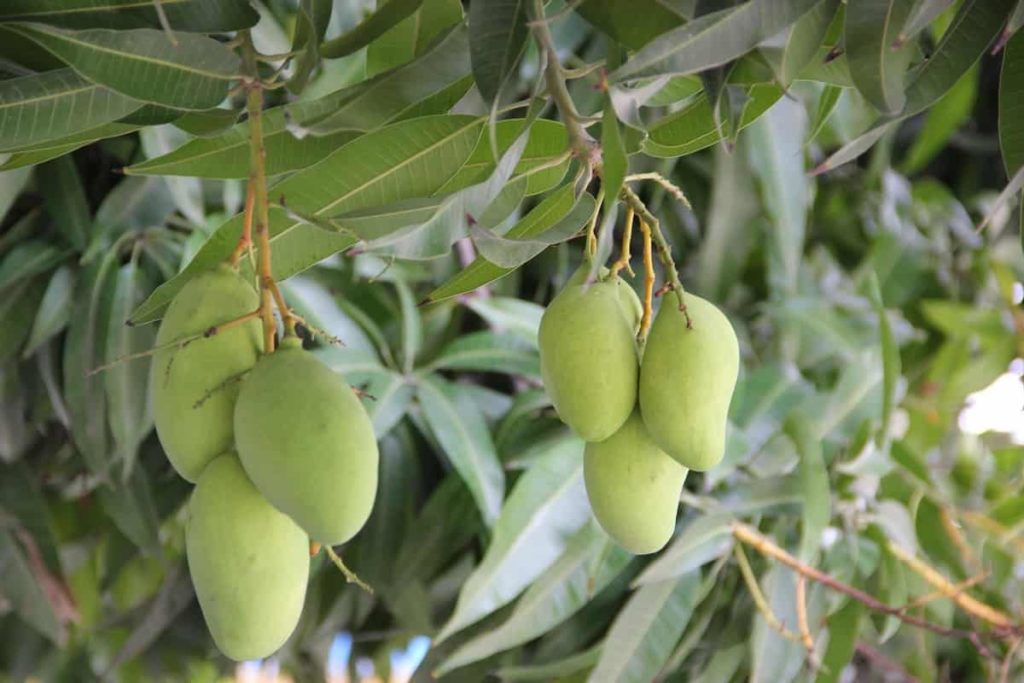
Anthracnose disease
Anthracnose disease also causes brown leaves. It is a type of fungus where it attacks leaves. It will produce black or brown spots on leaves.
Solution – You need to use fungicides to eliminate them to control this disease. It would be great to control them as soon as possible and keep the tree in good condition. When the tree is not under stress, it will give you more delicious fruits.
The Mango tree doesn’t grow
Cold weather
Cold weather can cause Mango trees to grow slow down. The Mango tree will need time to establish its roots in the cold months. The small Mango tree is growing slowly, almost nothing noticeable.
Poor soil
The Mangoes that are planted in poor soil will grow incredibly much soil. Very sandy soil will have less nutrient content and will not contain water. Soil containing a lot of clay will hold a lot of water and rot the roots.
Solution – The perfect soil for Mango trees has been improved with lots of natural organic matter. Before planting new Mango trees, add compost, aged cow manure, and a handful of pelleted chicken manure.
Dehydration
Mangoes that suffer from dry spells, especially young ones, will slow their growth. The tree w struggle to absorb the nutrients it needs and may die completely.
Solution – To keep your Mango tree growing fast, water it regularly when they are first planted and in the summer months. In dry winter, Mango trees will also need extra water to keep them healthy before the spring growing season.
Lack of sunlight
Mango trees need bright sunlight, so a lack of light can slow their growth. Mangoes that get too much shade will slow down and take more time to produce fruit.
Solution – Removing more hanging branches from other trees and shrubs can help the Mango tree get the sunlight it needs to grow faster. You should plant them in an open yard area to help them reach as much light as possible and encourage vertical growth.
Lack of fertilizer
Mango trees need nutrients to grow faster, so a lack of good fertilizers can cause problems.
Solution – Use organic and natural fertilizers such as pelleted chicken manure and fish emulsion.
In case you missed it: Fertilizer Management in Mango: Homemade, Organic, Compost, Liquid, and Schedule
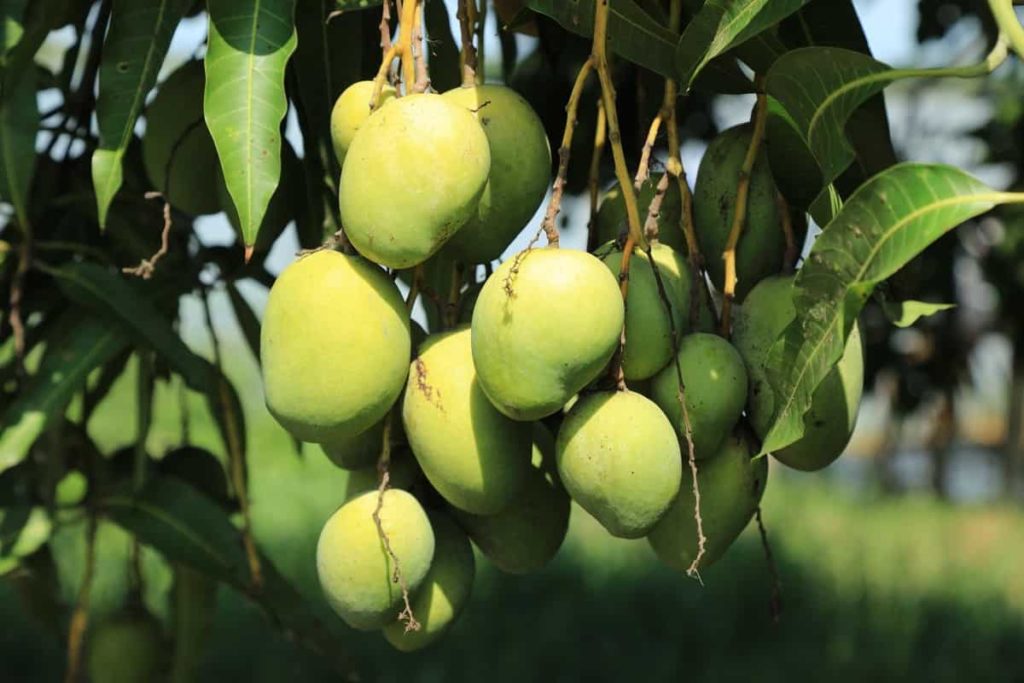
Diseases
Powdery Mildew
Symptoms of the disease’s characteristics are the white surface powdery growth of the fungal spores on parts.
Solution – The cutting off diseased leaves and during flower season, three sprays of systemic fungicides are prescribed at intervals of 12 to 15 days. The first spray is prescribed when 25% of flowers bloom.
Anthracnose
Anthracnose appears on different parts of the Mango tree. Symptoms of characteristics anthracnose appear as oval or irregular brown to dark brown spots of different sizes scattered on the leaf surface.
Solution – Diseased leaves, flowers, twigs, and fruits dropped in the garden should be collected, and all the twigs affected by the tree should be cut and burned. Bloom infection can be effectively controlled by two to three sprays of contact or systemic fungicides during spring at intervals of 12 to 15 days.
Alternaria leaf spot
Symptoms first appear as small, brown round spots on the surface of the leaves. Later, the higher concentration of brown and black spots is equally on the leaf lamina. Symptoms are more prominent at the bottom of the leaves.
Solution – The disease can be controlled by regular field spray programs, including copper-based fungicides.
Bacterial canker
The halos on young leaves are large and separate, while narrow on old leaves can only be observed against the light. Under severe infection, the address turns yellow and falls.
Solution – Regular inspection of gardens, sanitation, and confirmation of seedlings are recommended as preventive measures against the disease. Copper-based fungicides spray effective in controlling bacterial cankers.
Stem end rot
The fruit suddenly turns black from brown while ripening, usually at the end of the stem. Within two to three days, the whole fruit turns black, and the disease moves downwards, thus adding half the fruit area.
Solution – Quick and proper handling of fruit can minimize disease causes. Pre-harvesting sprays of any systemic fungicides or copper-based fungicides reduce the incidence.
Pests
Fruit fly
The maggots are eaten inside the fruit, making the flush brown and soft, causing a foul odor. The damage also serves as an entry place for fungal and bacterial pathogens.
Solution – Collect and destroy the fallen fruits. Also, harvest the fruits quickly to reduce the loss of flies. If the infection is a severe spray, the proper pesticide.
White Mango scale
Scale insects suck the juice from leaves, branches, and fruits, cause defoliation, dry young twigs, poor blossoming, and affect fruit quality by causing significant pink spots. The attack of young plants results in backward growth. In a severe attack, the fruits can fall prematurely while the size of mature fruits decreases.
Solution – Remove and burn the infected plant’s parts. Spraying appropriate pesticides in recommended quantities will help reduce the population of the scale.
Conclusion
Mango trees are recreational plants to grow at home and will thrive if you live in a tropical, subtropical, or even temperate climate. They need regular water, well-drained soil, and regular fertilizer to thrive. You should feed Mango plants with pelleted chicken manure in spring and fall to grow well and avoid any nitrogen deficiency. Mango trees are growing fast and will reward you with Mangoes once established.
- Flower Garden Designs and Layouts for Beginners
- Planting and Spacing Techniques in Papaya: A Beginner’s Guide
- Growing Gold: Essential Techniques for Planting Pineapples
- How to Make Kalanchoe Plant Bushy: Home Remedies and Solutions
- 11 Reasons Why Your Gardenia is Not Blooming: Home Remedies and Solutions
- Eco Elegance: The Guide to Designing a Drought-Tolerant Landscape
- Gardening on a Slope: Strategies for Hillside Landscaping
- Nourish and Flourish: Top Organic Mulches for Thriving House Plants
- Everything You Want to Know about Indian Mogra Flower: Discover Uses and Growing
- Green Thumb Success: Expert Tips for Cultivating Greenhouse Pumpkins All Year Round
- Maximize Growth & Flavor: The Ultimate Guide to Companion Planting in Herb Gardens
- How to Control Rhododendron Problems Naturally: Home Remedies and Organic Ways to Fix Them
- Natural Magic: The Remarkable Benefits of Cinnamon for Plants
- Best Steps to Revive Dying Tulip with Natural and Organic Treatment
- 10 Reasons Why Your Angel Trumpet is Not Blooming: Remedies and Treatment
- How to Fix Periwinkle Leaf and Flower-Related Problems: Natural Remedies and Solutions
- How to Fix Zinnias Leaf and Flower Problems: Discover Natural and Home Remedies
- Organic Steps to Induce Lemon Tree Flowers: A Comprehensive Guide
- Bloom Booster: Crafting the Perfect Homemade Bougainvillea Fertilizer
- Optimizing Growth: A Guide to Applying NPK Fertilizer for Potted Plants
- 10 Best Homemade Fertilizers for Rubber Plant: DIY Recipes and Application Method
- How to Boost Female Pumpkin Flowers: Effective Steps for More Flowers and High Yields
- Transform Your Indoor Garden: Top Benefits of Pink Salt for Houseplants
- 10 Best Homemade Fertilizers for Peacock Plants (Calathea): Easy DIY Guide
- Unlock Blooms: 9 Reasons Why Your Potted Chrysanthemum is Not Blooming
- 8 Reasons Why Your Potted Hibiscus is Not Blooming: Fix it with Simple Solutions
- Unlock Blooms: 9 Key Reasons Your Potted Frangipani Won’t Flower
- 10 Reasons Why Is My Ice Plant Not Blooming: Remedies and Treatment
- 10 Reasons Why My Potted Hydrangea Not Blooming: Treatment and Remedies
- 10 Reasons Why is My Wisteria Not Blooming: Remedies and Treatment
- 10 Reasons Why is My Goldfish Plant Not Blooming: Remedies and Treatment
- Maximize Your Space: Ultimate Guide to Balcony Gardening with Grow Bags
- 10 Reasons Why Your Iris is Not Blooming: Remedies and Treatment
- 10 Reasons Why Your Anthurium Plant is Not Blooming: Treatment and Remedies
- 10 Reasons Why Your Aquaponic Plants Are Not Flowering: Remedies and Treatment
- 10 Reasons Why Your Agapanthus is Not Flowering: Remedies and Treatment